ASUS P8Z77-V Deluxe Review - Know Your SKU
by Ian Cutress on May 12, 2012 8:45 AM EST- Posted in
- Motherboards
- Asus
- Z77
3D Movement Algorithm Test
The algorithms in 3DPM employ both uniform random number generation or normal distribution random number generation, and vary in various amounts of trigonometric operations, conditional statements, generation and rejection, fused operations, etc. The benchmark runs through six algorithms for a specified number of particles and steps, and calculates the speed of each algorithm, then sums them all for a final score. This is an example of a real world situation that a computational scientist may find themselves in, rather than a pure synthetic benchmark. The benchmark is also parallel between particles simulated, and we test the single thread performance as well as the multi-threaded performance.
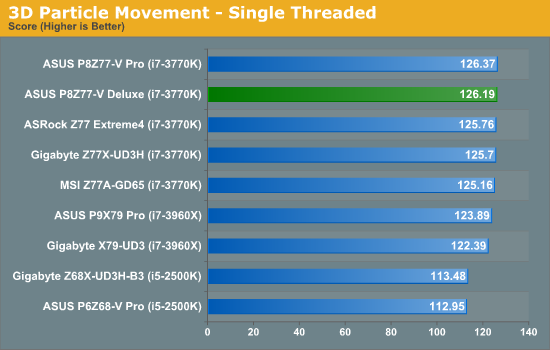
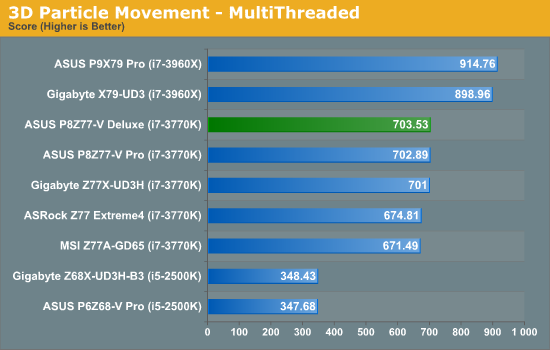
Using aggressive BIOS settings, the Deluxe comes top of our Ivy multithreaded test on 3DPM, and only misses out in the single threaded test by the tiniest of margins.
WinRAR x64 3.93 - link
With 64-bit WinRAR, we compress the set of files used in the USB speed tests. WinRAR x64 3.93 attempts to use multithreading when possible.

The Deluxe smashes our previous WinRAR timings, comfortably coming ahead of all the other Z77 motherboards.
FastStone Image Viewer 4.2 - link
FastStone Image Viewer is a free piece of software I have been using for quite a few years now. It allows quick viewing of flat images, as well as resizing, changing color depth, adding simple text or simple filters. It also has a bulk image conversion tool, which we use here. The software currently operates only in single-thread mode, which should change in later versions of the software. For this test, we convert a series of 170 files, of various resolutions, dimensions and types (of a total size of 163MB), all to the .gif format of 640x480 dimensions.
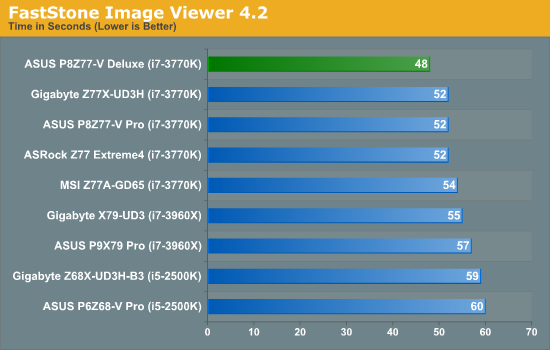
The Deluxe also posts a significantly better time in our FastStone Image test.
Xilisoft Video Converter
With XVC, users can convert any type of normal video to any compatible format for smartphones, tablets and other devices. By default, it uses all available threads on the system, and in the presence of appropriate graphics cards, can utilize CUDA for NVIDIA GPUs as well as AMD APP for AMD GPUs. For this test, we use a set of 32 HD videos, each lasting 30 seconds, and convert them from 1080p to an iPod H.264 video format using just the CPU. The time taken to convert these videos gives us our result.

Seemingly unstoppable, the Deluxe also comes top of our Video conversion test.
x264 HD Benchmark
The x264 HD Benchmark uses a common HD encoding tool to process an HD MPEG2 source at 1280x720 at 3963 Kbps. This test represents a standardized result which can be compared across other reviews, and is dependant on both CPU power and memory speed. The benchmark performs a 2-pass encode, and the results shown are the average of each pass performed four times.
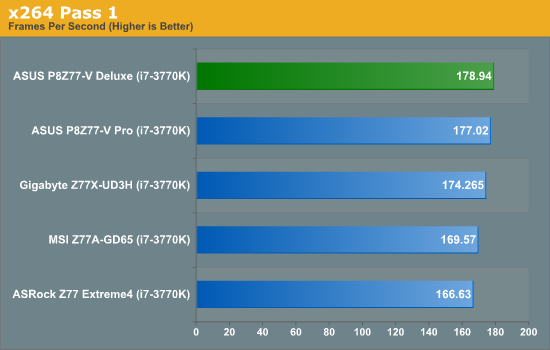
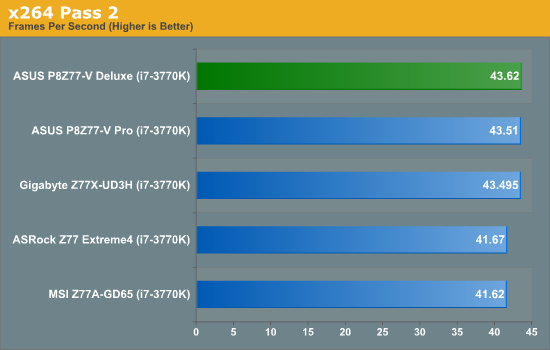
To round off a near perfect string of 2D results, the Deluxe comfortably comes out top in our x264 test.










52 Comments
View All Comments
KivBlue - Saturday, May 12, 2012 - link
Don't get me wrong, I like ASUS but they are pricey for what they offer, and I think Gigabyte is decent but they lack something in software side of things, I really feel like the choices are rather limited. EVGA has a chance to step up their game and put a stamp in the motherboard market just by coming up with a 2 or 3 model line-up for Z77 chipset catered at low to mid level, because FTW at the moment is out of the price range for most people to even consider.IanCutress - Monday, May 14, 2012 - link
Hi KivBlue,We review what we get in, and we test in our spare time alongside a full time job. I currently have 12 boards in to get through, unfortunately no EVGA. We may get hold of one soon though.
Ian
jimmyzaas - Sunday, May 13, 2012 - link
Please review the premium Gigabyte UD5H board as well. I compared it closely with this deluxe board and it seemed to have everything this board has except wifi. It's also a full $70 cheaper.IanCutress - Monday, May 14, 2012 - link
Hi JimmyZaas,This board just came through my door. I have other boards to test ahead of it, and then Computex, and then I'll will have a chance to take a look.
Ian
falc0ne - Sunday, May 13, 2012 - link
both from my user and my IT experience(5 years as hardware technical support) MBs with more features are more prone to fail than others with less features.I had a Deluxe version of ASUS with the whole bulk of features, including wi-fi, dedicated antena, 24bit 192Khz audio card, lots of USBSs and SATA etc.
Problems I had :
-ASUS temp monitoring utility didn't report an accurate temperature
-wireless not reliable, support software was very poor
-After 1 year of usage blue screens with message "IRQ not less or equal". Done my own investigation and found out that enabling devices in BIOS would work. Worked for a while and now the MB even after that fix still has random BSOD + random fail to boot issues.
-
At this moment imagine that I am reluctant to buy any of these boards with 100+ features.
OK, on paper they look great, but do they actually work? Who can tell how reliable this MB will be after 1 year of usage?
My take is, mine got busted after doing a very mild overclocking. I only increased the frequency from 2.3 to 2.9 Ghz, all done by the book.
Bottom line,make a thourgh reasearch when you buy one of these
Ratman6161 - Sunday, May 13, 2012 - link
Not that many people will want to be doing that. But for the Z68 boards in the test you use a 2500K. I think it might be interesting to also see a 2500K in the Z77 boards just to see if there is any difference in performance attributable to the different chipsets. I kind of suspect there would be no difference.DarkRogue - Sunday, May 13, 2012 - link
First off, thanks again Ian for a good review.I see you've added a few more tests and are generally improving upon the last mobo review article.
I also appreciate your taking the time to try and explain the voltage ripple situation in the article, enve if I still don't quite understand it, haha.
However, one that that still puzzles me is probably one of the best features of the ASUS boards so far - Fan Xpert 2. I'm getting a lot of conflicting information about whether or not they can control the speed of 3-pin (non-PWM) fans, such as the Nexus D12SL-12 ort he newer Scythe Kama Flow 2's (which seems to have replaced the older Scythe S-FLEX series.)
I've read that the fan headers do support fan control of those fans, and also that some headers don't support it, which is very confusing. It would be extremely helpful if you could delve into the software suite and test out the fan control on a couple non-PWM fans. Furthermore, I can't find any mention if the mboo controls 3-pin fans via voltage variation, or still tries to do some kind of PWM by pulsing the 12v on and off.
In particular, not all fan headers are created equal on every mobo, so it would be helpful to know where the differences lie.
Basically, besides the hardware, every manufacturer is trying to differentiate themselves with their software suite, and it would be a good idea to try them out and note how stable/buggy they are, if they perform well, if there are any competitive products, etc.
Otherwise, I'm liking the improvements in the review.
maximumGPU - Sunday, May 13, 2012 - link
i have the board with three 3-pin fans plugged into it. Fan Xpert can control their speed just fine.DarkRogue - Sunday, May 13, 2012 - link
Which headers do you have them plugged into?I have heard that the Chassis headers can control 3-pin and 4-pin fans, but that the CPU and CPU_OPT headers can only control 4-pin fans.
Do you know if they are controlled via voltage (for example, feeding 8v to the fan) or if it simply pulses 12v on and off?
IanCutress - Monday, May 14, 2012 - link
Hi DarkRogue,ASUS confirm that the chassis fan headers (labelled CHA) should be able to control 3-pin fans.
Regarding software, AI Suite has been pretty stable for the last 6-8 ASUS boards I've gone through, so I didn't mention anything new here. If software bugs me during testing, by not doing what it should, I do mention it where I can :)
All the best,
Ian